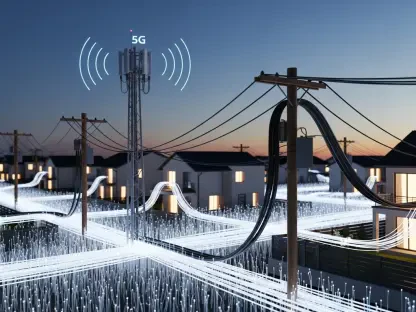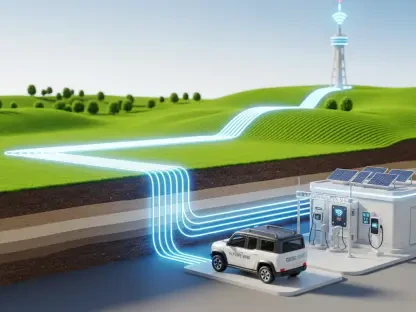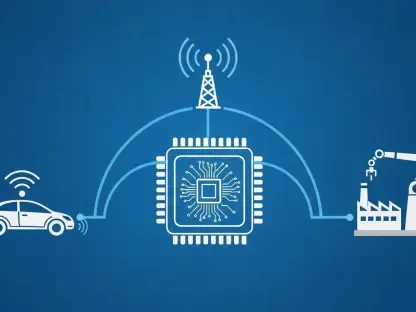In the sprawling landscapes of rural America, where nearly a quarter of the U.S. population resides, the struggle for reliable internet access has been a persistent barrier to progress, compounded by vast distances, rugged terrain, and sparse populations that make traditional wired infrastructure impractical. This digital divide isn’t merely a technological gap—it stifles education, limits access to healthcare, and curbs economic opportunities that urban areas often take for granted. Yet, a quiet revolution is underway, driven by wireless technology that promises to rewrite the rules of connectivity. Innovations like Fixed Wireless Access (FWA) and spectrum-sharing models are stepping in where cables fail, offering scalable, cost-effective solutions. This transformation is not just about internet access; it’s about empowering rural communities to thrive in a connected world. Let’s delve into how these advancements are reshaping the future for those often left behind.
Breaking Down the Barriers to Rural Connectivity
The importance of broadband internet in today’s world cannot be overstated, as it underpins everything from remote learning to telemedicine and business growth. However, rural America faces formidable challenges in achieving this connectivity. With low population density and homes scattered across miles of challenging terrain, the logistics of providing internet access become daunting. Traditional providers often find the return on investment too low to justify extending services to these areas, resulting in a persistent digital divide. This gap affects nearly every aspect of life, from students unable to complete online assignments to farmers missing out on precision agriculture tools. The reality is that without reliable internet, rural communities are cut off from the resources and opportunities that define modern living, perpetuating inequality on a grand scale. Addressing this issue requires more than just willpower; it demands innovative approaches that can overcome both geographical and economic hurdles.
Beyond the physical challenges, the digital divide in rural areas also carries profound social and economic consequences. Families without internet access struggle to keep up with educational demands, as online learning becomes a standard part of curricula. Small businesses, which form the backbone of many rural economies, lose competitive edge without the ability to market online or process digital transactions. Healthcare, too, suffers when patients cannot access telehealth services, forcing them to travel long distances for basic care. The ripple effects of this disconnect touch every corner of rural life, highlighting the urgent need for solutions that can deliver connectivity where traditional methods fall short. Fortunately, technology is evolving to meet these needs, offering hope that rural America can finally join the digital mainstream without being held back by the limitations of location or infrastructure costs. This shift is not just a convenience—it’s a lifeline for millions.
The Shortcomings of Traditional Wired Systems
For more than a century, wired networks such as cable and fiber have served as the foundation of communication across the nation, delivering reliable service in densely populated urban and suburban areas. However, their effectiveness diminishes drastically in rural settings where homes are spread far apart. The cost of laying cables or installing fiber to a single rural household can exceed $50,000, a figure that often doubles for more complex installations. Such staggering expenses make it economically unfeasible for providers to expand into these regions, leaving vast swaths of the population without access to high-speed internet. This financial barrier reinforces the digital divide, ensuring that rural residents remain stuck with outdated or nonexistent connectivity while their urban counterparts enjoy the benefits of modern technology. Clearly, relying solely on wired infrastructure is an outdated approach that fails to address the unique needs of less populated areas.
Moreover, the slow pace of wired network deployment exacerbates the problem, as it can take years to plan and execute such projects in remote locations. Even when funding is secured, the physical challenges of navigating rough terrain or securing rights-of-way add further delays. For rural communities desperate for connectivity, this timeline is simply unacceptable, as each passing year without internet access widens the gap in education, job opportunities, and quality of life. The reliance on legacy systems also ignores the reality that many rural areas may never see wired solutions due to sheer cost and complexity. This situation underscores the need for alternative technologies that can bypass the limitations of traditional infrastructure, delivering fast and affordable internet without the burden of extensive physical networks. Wireless solutions are stepping into this void, proving that connectivity doesn’t have to be tethered to cables to be effective.
Fixed Wireless Access: A New Frontier for Connectivity
Fixed Wireless Access (FWA) emerges as a transformative solution, offering a way to deliver high-speed broadband without the prohibitive costs of wired infrastructure. By utilizing specific spectrum bands authorized by the Federal Communications Commission (FCC), FWA transmits internet signals over the air, reaching remote locations that cables cannot feasibly serve. This technology can connect isolated farms, small towns, and rural homes within its range, drastically reducing both the financial and logistical barriers to access. Unlike wired systems that require extensive digging and installation, FWA can be deployed relatively quickly, making it a practical choice for areas where time and cost are critical factors. This approach is not just a stopgap measure—it’s a robust alternative that provides speeds comparable to urban networks, ensuring that rural residents are no longer left behind in the digital race.
The versatility of FWA also makes it a standout option for addressing rural connectivity challenges. It can adapt to a variety of environments, from flat farmlands to mountainous regions, without the need for extensive groundwork. This flexibility allows providers to scale services based on local demand, avoiding the overinvestment risks associated with wired networks. Additionally, the lower deployment costs mean that even smaller operators can enter the market, fostering competition and driving down prices for consumers. For rural communities, this translates to faster access to reliable internet, enabling everything from online education to e-commerce. The impact of FWA goes beyond mere connectivity; it’s a catalyst for economic growth and social inclusion, proving that technology can level the playing field when traditional methods fall short. As adoption grows, FWA is reshaping how rural America engages with the digital world.
Local Innovators: The Role of Wireless Internet Service Providers
Wireless Internet Service Providers (WISPs) stand at the forefront of the rural connectivity revolution, acting as local champions who understand the unique needs of their communities. For decades, these hometown operators have been building networks with accessible equipment, connecting neighbors, farms, and small businesses long before major providers took notice. Unlike large corporations, WISPs operate with agility, often deploying solutions tailored to the specific challenges of their regions. Today, with advancements in technology, they offer internet speeds that rival fiber at a fraction of the cost and deployment time, outpacing bigger competitors in both innovation and affordability. Their deep-rooted commitment to rural areas makes them indispensable, as they bridge gaps that national providers often overlook, ensuring that even the most remote households gain access to the digital tools they need to thrive.
The success of WISPs lies in their ability to adapt and innovate, often under tight budgets and with limited resources. By leveraging modern wireless technologies, they’ve transformed from small-scale operators into key players delivering high-quality broadband to underserved areas. This grassroots approach not only fosters local economic growth by supporting small businesses and agriculture but also builds trust within communities that value personalized service over corporate detachment. Furthermore, WISPs often reinvest profits directly into network improvements, ensuring sustained reliability and expansion. Their impact is evident in the millions of rural residents now connected through their efforts, demonstrating that local solutions can have a national impact. As wireless tech continues to evolve, WISPs remain pivotal in ensuring that rural America isn’t just catching up but is poised to lead in certain aspects of digital inclusion.
Spectrum Innovation with Citizens Broadband Radio Service
The Citizens Broadband Radio Service (CBRS) represents a groundbreaking advancement in wireless technology, offering a mid-band spectrum that perfectly balances speed, range, and capacity for rural connectivity. Unlike traditional spectrum allocations, CBRS operates on a shared model, managed by a Spectrum Access System, allowing both government and commercial users to coexist safely. This efficient use of limited resources makes it an ideal substitute for wired networks, particularly in remote areas where infrastructure costs are prohibitive. With setup expenses as low as 20% of wired alternatives, CBRS enables providers to deliver high-speed internet for diverse applications, from precision agriculture to rural healthcare services. Its rapid adoption—evidenced by hundreds of thousands of base stations nationwide—highlights its scalability and economic value, positioning it as a cornerstone of the wireless revolution in underserved regions.
Beyond cost savings, CBRS empowers smaller providers to compete in a market often dominated by large corporations, leveling the playing field for rural connectivity. The absence of expensive spectrum licenses lowers entry barriers, allowing local operators to deploy services quickly and affordably. This has resulted in significant coverage gains, with a substantial portion of rural broadband connections now relying on CBRS-based solutions. The technology’s flexibility also supports both fixed and mobile deployments, catering to a wide range of community needs, whether it’s connecting a single household or enabling smart farming across vast fields. For rural America, this innovation translates to internet access delivered in weeks rather than years, closing the digital divide at an unprecedented pace. As CBRS continues to expand, its role in transforming how rural communities engage with technology cannot be understated, offering a glimpse into a future of universal connectivity.
Building a Connected Future for Rural Communities
Reflecting on the strides made, it’s evident that wireless technology has carved a path where wired systems stumbled, bringing rural America into the digital fold with remarkable speed. Fixed Wireless Access and the Citizens Broadband Radio Service have reshaped the landscape, connecting millions of households that once languished without reliable internet. Local Wireless Internet Service Providers have played a crucial role, weaving networks of opportunity through innovation and grit, ensuring that no community is left behind. Their efforts, paired with spectrum-sharing advancements, have tackled the economic and logistical barriers that long plagued rural connectivity, proving that technology can adapt to even the toughest challenges. This transformation wasn’t just about access; it redefined how rural residents live, work, and learn, narrowing the gap that once seemed insurmountable.
Looking ahead, the focus must shift to sustaining and expanding these gains through continued investment in wireless infrastructure and supportive policies. Encouraging collaboration between local providers and federal initiatives can accelerate deployment, ensuring that remaining unconnected areas receive attention. Additionally, fostering education on digital tools will empower rural residents to fully leverage their newfound connectivity for economic and social growth. Exploring further spectrum innovations could unlock even greater potential, addressing future demands as technology evolves. The journey doesn’t end with current achievements; it’s about building resilience and adaptability into rural networks to withstand emerging challenges. By prioritizing scalable solutions and community-driven efforts, the digital divide can be not just bridged but erased, securing a future where every American, regardless of location, thrives in a connected world.









